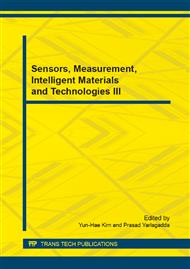[1]
Y. Mileva, A. Bruhn, and J. Weickert. Illumination-robust Variational Optical Flow with Photometric Invariants., Pattern Recognition, (2007), pp.152-159.
DOI: 10.1007/978-3-540-74936-3_16
Google Scholar
[2]
T. Brox, A. Bruhn, N. Papenberg, and J. Weickert. High accuracy optical flow estimation based on a theory for warping., European Conference on Computer Vision (ECCV), (2004), p.25–36.
DOI: 10.1007/978-3-540-24673-2_3
Google Scholar
[3]
Bergen J R, Anandan P, Hanna K J, et al. Hierarchical model-based motion estimation" Computer Vision—ECCV, 92, (1992), pp.237-252.
DOI: 10.1007/3-540-55426-2_27
Google Scholar
[4]
Szeliski R. Video mosaics for virtual environments., Computer Graphics and Applications, IEEE, Vol. 16, (1996), pp.22-30.
DOI: 10.1109/38.486677
Google Scholar
[5]
Hu, Rong, et al. Video stabilization using scale-invariant features. " Information Visualization, 2007. IV, 07. 11th International Conference. (2007).
DOI: 10.1109/iv.2007.119
Google Scholar
[6]
R. Szeliski, Image Alignment and Stitching: A Tutorial, Technical Report MSR-TR- 2004-92, Microsoft Corp., (2004).
Google Scholar
[7]
Y. Wexler, E. Shechtman, and M., Irani, Space-time video completion., Proc. IEEE Conf. Computer Vision and Pattern Recognition, Vol. 1, (2004), p.120–127.
DOI: 10.1109/cvpr.2004.1315022
Google Scholar
[8]
Farid, Hany, and Jeffrey B. Woodward. Video stabilization and Enhancement., TR2007-605, Dartmouth College, Computer Science, (1997).
Google Scholar
[9]
Matsushita Y, Ofek E, Ge W, et al. Full-frame video stabilization with motion inpainting,. Pattern Analysis and Machine Intelligence, Vol. 28(2006).
DOI: 10.1109/tpami.2006.141
Google Scholar
[10]
Wedel A, Pock T, Zach C, et al. An improved algorithm for TV-L1 optical flow, Statistical and Geometrical Approaches to Visual Motion Analysis. (2009), pp.23-45.
DOI: 10.1007/978-3-642-03061-1_2
Google Scholar
[11]
Rudin L I, Osher S, Fatemi E. Nonlinear total variation based noise removal algorithms,. Physica D: Nonlinear Phenomena, Vol. 60, (1992), pp.259-268.
DOI: 10.1016/0167-2789(92)90242-f
Google Scholar
[12]
Chambolle A. Total variation minimization and a class of binary MRF models, Energy minimization methods in computer vision and pattern recognition. (2005), pp.136-152.
DOI: 10.1007/11585978_10
Google Scholar


